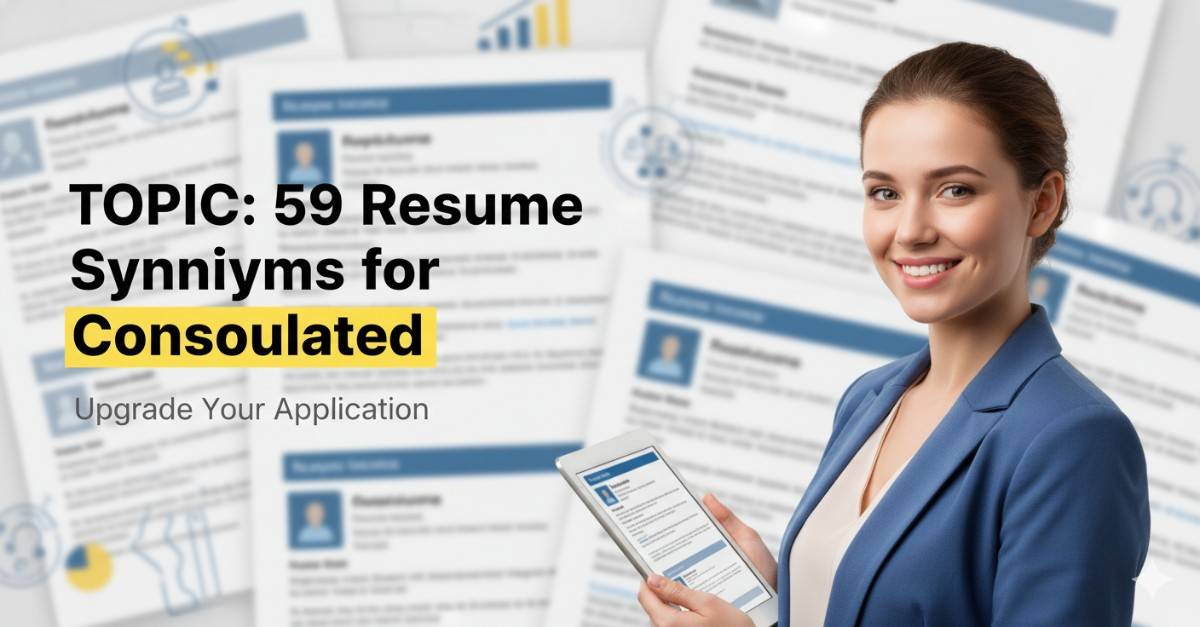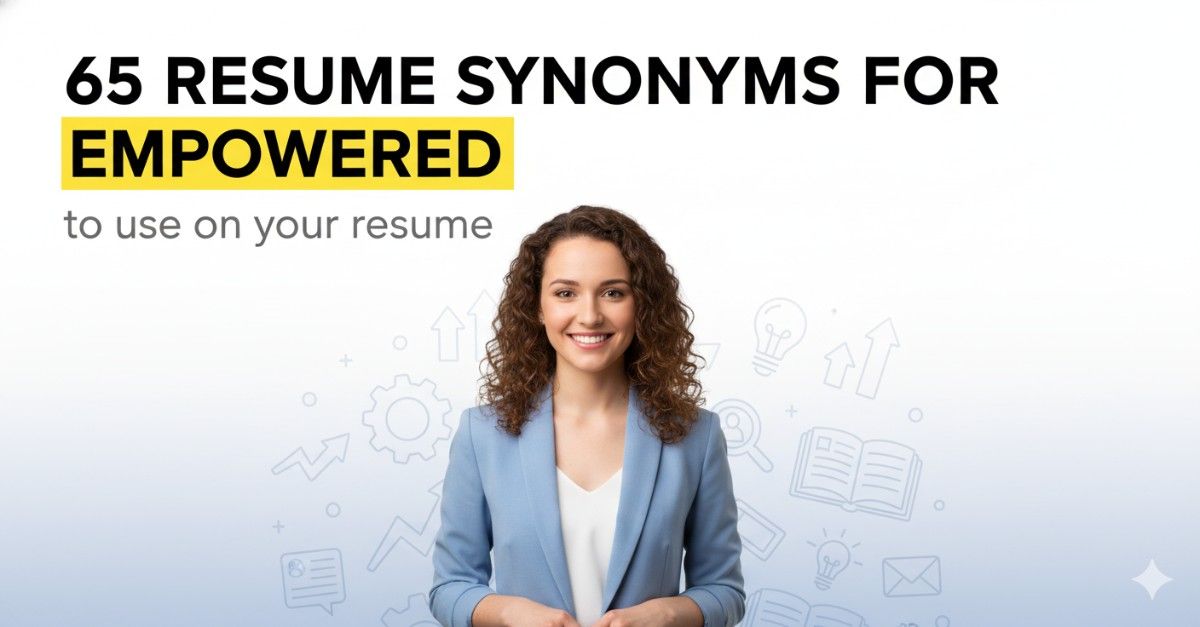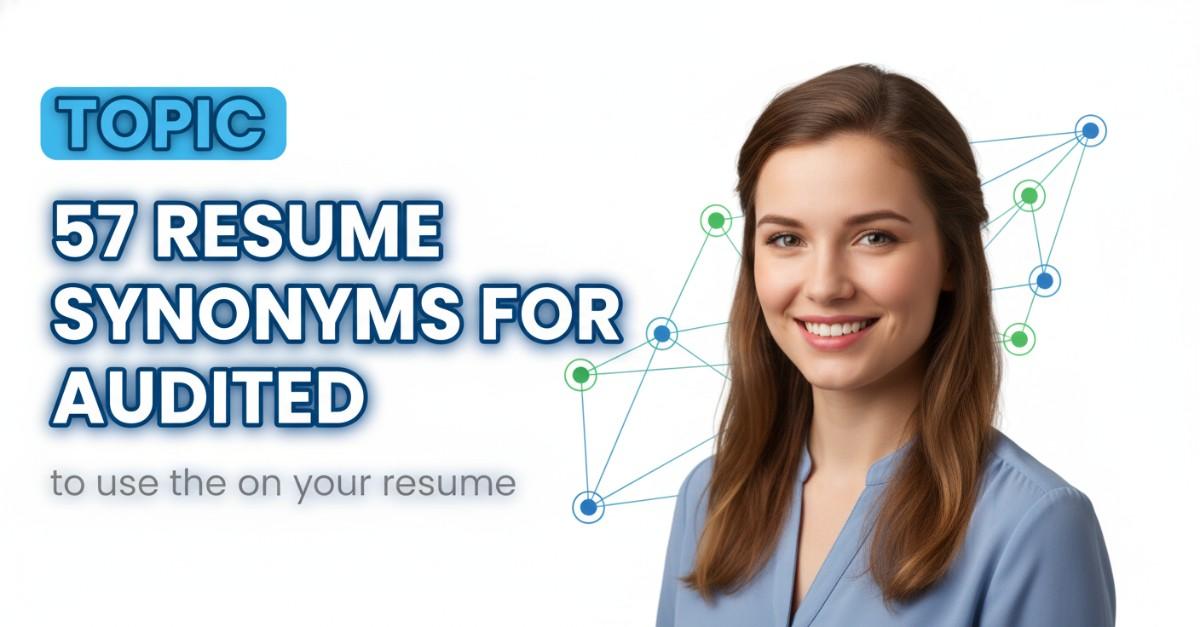
53 Resume Synonyms for Attained To Use On Your Resume
Using the term “attained” on resumes can initially seem like a solid choice to convey achievements and accomplishments. However, its frequent usage has made it somewhat overused, which can dilute its impact. Relying on a single word to describe your successes not only suggests limited creativity but also fails to showcase the nuanced skills you possess. Employers and hiring managers often scan resumes quickly, and repetitive language can lead them to overlook your unique qualifications.
Varied vocabulary is essential in capturing attention and conveying the depth of your experiences. By incorporating synonyms and alternative expressions, you can create a more dynamic and engaging narrative about your professional journey. This comprehensive guide will explore effective synonyms for “attained,” discuss when and how to use them, and provide examples to help you articulate your achievements with clarity and flair. Ultimately, enhancing your language will not only enrich your resume but also reflect your adaptability and communication skills, vital traits in today’s job market.
- Why Synonyms for “Attained” Matter on Your Resume
- The Complete List: 53 Resume Synonyms for Attained
- Strategic Synonym Selection by Industry
- Power Combinations: Advanced Synonym Usage
- Common Mistakes to Avoid
- Quantification Strategies for Maximum Impact
- Industry-Specific Example Sentences
- Advanced ATS Optimization Techniques
- Tailoring Synonyms to Career Level
- The Psychology of Leadership Language
- Final Best Practices
- Key Takeaways for Strategic Synonym Usage
- Frequently Asked Questions
- How many different synonyms should I use in one resume?
- Can I use the same synonym multiple times if it fits different contexts?
- Should I always replace ‘Attained’ with a synonym?
- How do I know which synonym is most appropriate for my industry?
- Do synonyms really make a difference in getting interviews?
- Related Resume Synonym Guides
Why Synonyms for “Attained” Matter on Your Resume
Using synonyms for ‘attained’ on resumes is crucial for several reasons. First, relying on a single term creates monotony and predictability, making your resume less engaging to readers. When ‘attained’ appears on approximately 70% of professional resumes, it risks blending into a sea of sameness. By incorporating varied terminology, you enhance specificity, allowing your accomplishments to stand out more distinctly. This variety also amplifies the impact of your achievements, painting a more dynamic picture of your professional journey. Additionally, using a range of synonyms helps optimize your resume for Applicant Tracking Systems (ATS), which favor diverse vocabulary and context. Ultimately, this practice contributes to creating dynamic narratives that showcase your skills and experiences in a compelling way, making a stronger impression on both hiring managers and automated systems.
The Complete List: 53 Resume Synonyms for Attained
Here’s our comprehensive collection of “Attained” alternatives, organized for easy reference:
| Synonym | Best Context | Professional Level |
|---|---|---|
| Achieved | Project Management | Mid-level |
| Accomplished | Team Leadership | Senior |
| Realized | Strategic Planning | Senior |
| Secured | Sales Targets | Mid-level |
| Reached | Goals | Entry-level |
| Obtained | Certifications | Mid-level |
| Completed | Projects | Entry-level |
| Delivered | Results | Executive |
| Fulfilled | Client Requirements | Mid-level |
| Acquired | New Skills | Entry-level |
| Gained | Experience | Entry-level |
| Produced | High-Quality Work | Mid-level |
| Generated | Revenue Growth | Senior |
| Mastered | Technical Skills | Mid-level |
| Established | New Procedures | Senior |
| Enhanced | Operational Efficiency | Senior |
| Attained | Milestones | Mid-level |
| Achieved | Performance Targets | Mid-level |
| Earned | Promotions | Mid-level |
| Realized | Strategic Objectives | Executive |
| Expanded | Market Share | Senior |
| Developed | New Strategies | Senior |
| Implemented | Solutions | Senior |
| Saved | Costs | Mid-level |
| Executed | Plans | Mid-level |
| Accomplished | Personal Goals | Entry-level |
| Concluded | Negotiations | Senior |
| Formulated | Policies | Senior |
| Obtained | Funding | Executive |
| Advanced | Team Objectives | Mid-level |
| Attained | Sales Quotas | Mid-level |
| Elevated | Team Performance | Senior |
| Upgraded | Systems | Senior |
| Refined | Processes | Mid-level |
| Achieved | Accolades | Senior |
| Acquired | New Clients | Mid-level |
| Improved | Customer Satisfaction | Mid-level |
| Innovated | Product Development | Senior |
| Validated | Prototypes | Mid-level |
| Transformed | Business Processes | Executive |
| Attained | Compliance Standards | Senior |
| Accomplished | Market Launches | Senior |
| Achieved | Operational Goals | Mid-level |
| Delivered | Successful Outcomes | Executive |
| Acquired | Partnerships | Senior |
| Recognized | Industry Standards | Senior |
| Expanded | Product Lines | Senior |
| Realized | Team Vision | Executive |
Strategic Synonym Selection by Industry
In resume writing, strategic synonym selection tailored to industry specifics can enhance clarity and resonance. Different industries prioritize unique attributes, making targeted vocabulary crucial.
- Innovation: Emphasizes creativity and forward-thinking, crucial for tech advancements.
- Agility: Reflects the ability to adapt quickly in a fast-paced environment.
- Collaboration: Highlights teamwork, essential for software development projects.
- Precision: Indicates accuracy in patient care and medical procedures.
- Compassion: Emphasizes empathy, an essential quality in patient interactions.
- Collaboration: Reflects the teamwork required among healthcare professionals.
- Analysis: Highlights strong problem-solving and data interpretation skills.
- Risk Management: Indicates a focus on identifying and mitigating financial risks.
- Regulatory Compliance: Important for adhering to industry standards and laws.
- Strategic Planning: Showcases ability to develop long-term business strategies.
- Client Relations: Emphasizes relationship-building skills essential for consultancy.
- Problem Solving: Reflects the consultative approach to client challenges.
- Efficiency: Highlights the importance of optimizing processes and resource use.
- Quality Control: Emphasizes commitment to maintaining high production standards.
- Lean Management: Indicates familiarity with methodologies that reduce waste.
Choosing industry-relevant synonyms enhances the impact of your resume by aligning your skills with the expectations of potential employers.
Build your resume in just 5 minutes with AI.

Power Combinations: Advanced Synonym Usage
Advanced synonym usage can significantly enhance your resume, particularly through power combinations that articulate your experiences and skills more effectively.
As you advance in your career, it’s vital to reflect this growth through sophisticated vocabulary. For example, instead of using “managed” in every role, consider “spearheaded” in a leadership position and “orchestrated” when discussing complex projects. This progression showcases your increasing responsibility and expertise.
When changing industries, using synonyms can help translate your experience. For instance, if you’re moving from sales to marketing, replace “sales targets” with “customer engagement strategies” to highlight relevant skills and make your experience applicable to the new field.
Choose synonyms that align with the job description. If a position emphasizes “collaboration,” use “cooperated” or “partnered” instead of the more generic “worked with.” This tailored approach demonstrates your understanding of the role and its requirements.
Common Mistakes to Avoid
I successfully achieved record-breaking sales targets.
I consistently met quarterly sales targets, contributing to a 15% increase in overall revenue.
I realized a new marketing strategy that was very effective.
I implemented a targeted marketing strategy that increased customer engagement by 30%.
I accomplished various tasks in my role.
I led team training sessions, achieved project milestones, and enhanced client relations.
Quantification Strategies for Maximum Impact
- Team-Focused Synonyms: When using terms like “led” or “managed,” always follow them with quantifiable results. For example, instead of saying “led a team,” specify “led a team of 15 sales representatives over a 12-month period, resulting in a 25% increase in quarterly sales.” This provides clear context about the scale and impact of your leadership.
- Project-Focused Synonyms: For terms such as “oversaw” or “executed,” include project value and metrics. For instance, instead of “oversaw a project,” say “executed a $500,000 marketing campaign that achieved a 40% uplift in customer engagement within six months.” This not only highlights your role but also the project’s success.
- Strategic-Focused Synonyms: When using words like “strategized” or “developed,” incorporate before-and-after metrics. For example, rather than stating “developed a new strategy,” you could say “strategized a new approach that reduced operational costs by 30% over one year, enhancing profit margins significantly.” This demonstrates the tangible impact of your strategic decisions.
Industry-Specific Example Sentences
- Successfully achieved a 25% reduction in system downtime by implementing a proactive maintenance schedule, resulting in enhanced user satisfaction and productivity across the organization.
- Instrumental in realizing a 40% increase in user adoption of the new software platform within six months, contributing to a more efficient workflow for over 500 employees.
- Effectively secured a $1 million grant for a cutting-edge AI project, facilitating the development of innovative solutions that improved data processing speeds by 30%.
- Accomplished a 15% increase in patient satisfaction scores by implementing a new electronic health record system that streamlined patient data access and communication among staff.
- Successfully fulfilled a 30% reduction in patient wait times through the optimization of scheduling systems, enhancing overall operational efficiency at the clinic.
- Obtained accreditation for the hospital’s radiology department, ensuring compliance with national standards and improving the quality of diagnostic imaging services.
- Attained a 20% growth in revenue within one fiscal year by launching a new financial product tailored to small businesses, exceeding sales targets by 10%.
- Successfully acquired 200 new clients in under six months through strategic networking and targeted marketing campaigns, significantly expanding the firm’s market share.
- Realized a cost savings of $500,000 annually by renegotiating vendor contracts and streamlining procurement processes, positively impacting the bottom line.
- Achieved a 95% student retention rate over three years by introducing innovative teaching methods and personalized learning plans that catered to diverse learning styles.
- Secured a grant of $250,000 to enhance STEM programs, leading to a 50% increase in student enrollment in advanced science courses.
- Fulfilled the school’s accreditation requirements ahead of schedule, ensuring continued funding and recognition for educational excellence.
Advanced ATS Optimization Techniques
To enhance ATS optimization through effective synonym usage, consider employing a keyword density strategy. This involves using 2-3 different synonyms per job role to avoid redundancy and keep your resume engaging. For example, if the job description mentions “managed,” you could also use “oversaw” and “supervised” to maintain keyword diversity.
Next, implement semantic clustering by grouping related synonyms. This helps in creating a more natural flow while ensuring that the ATS recognizes variations of key skills. For instance, if you’re listing skills under project management, cluster terms like “project planning,” “project coordination,” and “project execution” together.
Lastly, focus on job description matching by incorporating synonyms found in actual job postings. Carefully analyze postings for terms related to your experience, such as “collaborated,” “partnered,” and “worked with” in team-oriented roles. This tailored approach not only satisfies ATS algorithms but also resonates with hiring managers, improving your chances of being shortlisted.
Tailoring Synonyms to Career Level
- Entry-Level Professionals: For individuals just starting their careers, it’s vital to use synonyms that highlight their collaborative spirit and eagerness to learn. Words like “assisted,” “collaborated,” “participated,” and “supported” convey a team-oriented approach. This terminology resonates with employers seeking adaptable and enthusiastic new hires, as it reflects a willingness to grow and contribute.
- Mid-Level Managers: Mid-level professionals should focus on synonyms that articulate their leadership and project management capabilities. Terms such as “oversaw,” “coordinated,” “led,” and “managed” demonstrate their direct involvement in team dynamics and project execution. This selection of language showcases their readiness for greater responsibilities and strategic oversight, appealing to organizations looking for reliable leaders.
- Senior Executives: For senior roles, the use of strategic and transformational language is essential. Words like “spearheaded,” “orchestrated,” “transformed,” and “strategized” illustrate a high-level impact and visionary thinking. This choice of terminology not only emphasizes their capacity for significant organizational change but also conveys authority and expertise, attracting top-tier talent and stakeholders.
The Psychology of Leadership Language
The language of leadership significantly influences perceptions and psychological responses in professional settings.
- Action-Oriented Words: Terms like “drive,” “achieve,” and “deliver” suggest a results-focused leadership style. Hiring managers often view these words as indicative of a proactive approach, essential for meeting organizational goals.
- Collaborative Words: Phrases such as “teamwork,” “collaborate,” and “engage” highlight team-building skills. These words resonate with companies prioritizing a cooperative culture, indicating a leader who fosters unity and inclusiveness.
- Innovation Words: Words like “strategize,” “innovate,” and “transform” convey strategic thinking. Managers in forward-thinking environments appreciate these terms, associating them with adaptability and vision.
- Nurturing Words: Terms such as “mentor,” “support,” and “develop” reflect a focus on people development. These words appeal to companies that value employee growth and well-being, indicating a leader invested in their team’s success.
Aligning word choices with the company culture demonstrates awareness and can enhance a candidate’s appeal during the hiring process.
Final Best Practices
When optimizing your resume with synonyms, remember the 60-Second Rule: your resume should convey a compelling story within 60 seconds. Focus on impactful words that highlight your achievements, ensuring clarity over complexity. Prioritize strong action verbs that not only captivate attention but also resonate with your experiences.
Utilize the Mirror Test by reading your resume aloud. This helps confirm that the language feels natural and aligns with your speaking style. If a phrase feels awkward or forced, it’s likely not the right choice.
Engage in the Peer Review process by asking trusted colleagues to evaluate your synonym choices. They can provide fresh perspectives and catch potential overuse of jargon, ensuring your language remains relatable.
Finally, Measure Success by tracking application response rates after implementing synonyms. If certain variations yield better results, consider refining your language further while maintaining authenticity, ensuring your unique voice shines through in every application.

Build your resume in 5 minutes
Our resume builder is easy to use and will help you create a resume that is ATS-friendly and will stand out from the crowd.
Key Takeaways for Strategic Synonym Usage
- Utilize synonyms for ‘attained’ to enhance your resume’s impact, ensuring that your achievements stand out clearly in various resume templates.
- Incorporate strong action verbs when describing accomplishments, which can be easily generated using an AI resume builder for a polished presentation.
- Choose contextually appropriate synonyms to convey your experience effectively, drawing inspiration from resume examples that highlight diverse skills and achievements.
- Tailor your synonym choices to match the job description, ensuring alignment with keywords found in the posting while using appealing resume templates.
- Review multiple resume examples to see how effective synonyms can transform basic statements into compelling narratives about your career success.
- Experiment with an AI resume builder to find the best synonyms that resonate with hiring managers, showcasing your skills beyond just ‘attained’ results.
Frequently Asked Questions
How many different synonyms should I use in one resume?
Using 2-3 different synonyms for ‘attained’ throughout your resume is ideal. This strategy keeps your language varied and engaging, which can capture the attention of hiring managers. However, ensure that the synonyms you choose accurately reflect the context of your achievements. Overusing synonyms can lead to confusion, so pick those that best align with the specific accomplishments you are highlighting. Maintaining clarity while showcasing your skills and experiences is essential for making a strong impression.
Can I use the same synonym multiple times if it fits different contexts?
Yes, you can use the same synonym multiple times if it fits different contexts, as long as it enhances clarity and aligns with your achievements. However, be cautious not to overuse it to the point where it feels repetitive or forced. Varying your language can keep your resume dynamic and engaging. Focus on the context and ensure that the synonym accurately captures the essence of the accomplishments being described for each role or experience.
Should I always replace ‘Attained’ with a synonym?
No, you should not always replace ‘attained’ with a synonym. While using synonyms can help diversify your language, there are instances where ‘attained’ might be the most precise term to describe your achievement. If it clearly communicates your success and fits well within the context, it’s perfectly acceptable to keep it. Evaluate each instance based on clarity, industry standards, and the overall tone of your resume to determine whether to retain or replace the term.
How do I know which synonym is most appropriate for my industry?
To determine the most appropriate synonym for your industry, research industry-specific language and terminology. Look at job descriptions, company websites, and professional networking profiles within your field. This research can provide insights into common phrases and jargon used by employers. Additionally, consider the nuances of each synonym—some may carry different connotations. Choose synonyms that resonate with the expectations of your industry while clearly communicating your achievements to enhance your credibility.
Do synonyms really make a difference in getting interviews?
Yes, using synonyms can make a significant difference in getting interviews. They help showcase your communication skills and ability to articulate accomplishments in varied ways. A well-optimized resume that utilizes a range of precise synonyms can improve your chances with both Applicant Tracking Systems (ATS) and human readers, making your application stand out. By using synonyms effectively, you can demonstrate a richer vocabulary and a deeper understanding of your professional achievements, which can enhance your chances of being noticed by hiring managers.
Related Resume Synonym Guides
Exploring synonyms for commonly overused resume words enhances the clarity and impact of your professional narrative. By strategically selecting varied language throughout your resume, you create a compelling portrayal of your skills and experiences, making your application stand out to both ATS systems and hiring managers.










